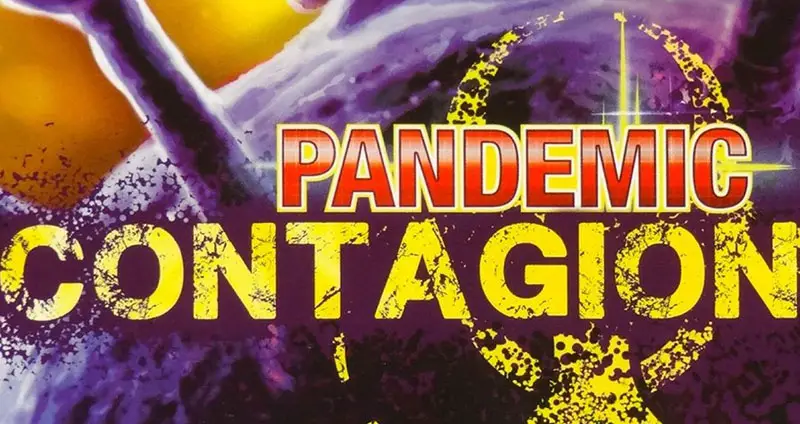
Components
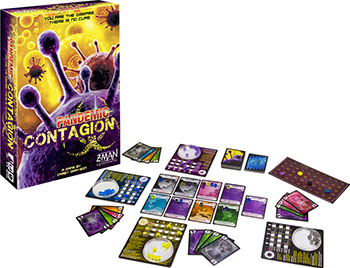
- 60 Contagion cards
- 24 City cards
- 12 Event cards
- 6 WHO cards
- 5 Player disease boards
- 5 Score markers
- 5 Petri dishes
- 75 Player disease cubes
- 1 Scoring board
- Instructions
Setup
for 3 - 5 players
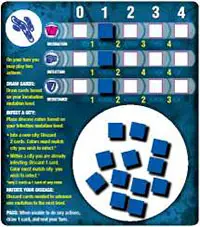
Determine a first player with the method of your choice.
Each player chooses a color and takes a Petri dish and the following in their color: 1 score marker, 1 player board and 15 disease cubes. Then, each of you must:
Place a disease cube on the Level 1 position of each mutation on your player board.
Place the Petri dish inside the circle on your player board and put your 12 remaining disease cubes inside.
Place your score marker near the "1" space of the scoring board.
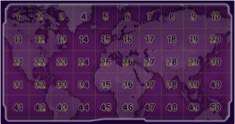
Shuffle and deal 4 Contagion cards to each player. Set remaining cards aside as a draw pile.
Shuffle and, according to table below, deal a number of City cards faceup in the middle the table. Set remaining cards aside.
- 3 players - deal out 8 city cards
- 4 players - deal out 9 city cards
- 5 players - deal out 10 city cards
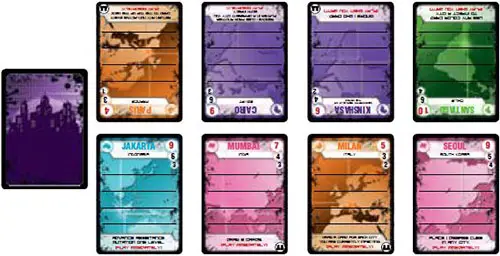
Starting with the last player and moving counter-clockwise, each player places 1 of their disease cubes in a city of their choice.
Shuffle separately the Event and WHO cards and, without looking, remove 3 of each type from the game. With the remaining cards, build the Event deck (from bottom up): 1 WHO card, 3 Event cards, 1 WHO card, 3 Event cards, 1WHO card, and 3 Event cards, for a total of 12 cards.

You are ready to begin!
Object of the Game
In Contagion, you play a deadly disease trying to exterminate human civilization through worldwide infection. Your goal: to be the player with the highest death toll (score) at the end of the game and win.
Game Play
At the start of each round, reveal the top card from the Event deck and read aloud for all players; that card is now active for the round.
Starting with the first player, resolve the event (as specified on the card) and take two actions. When finished, play continues clockwise.
Actions
On your turn take 2 of 3 available actions in any order. Actions may be repeated.
- Draw Cards
- Infect A City
- Mutate Your Disease
Note: If you cannot take any actions on your turn, instead draw one card and pass.
Draw Cards 
Draw into your hand as many cards from the Contagion cards pile as your Incubation mutation allows. Discard down to 9 (the maximum hand size) if needed. If the Contagion draw pile runs out, shuffle the discard pile to create a new one.
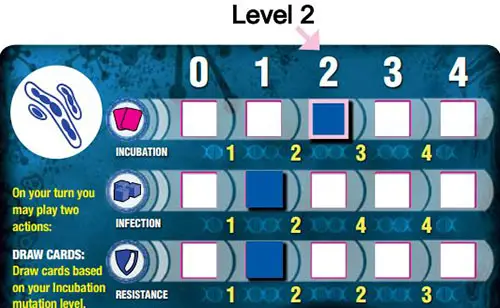
In this example, Blue draws 2 Contagion cards because her incubation mutation is at level 2.
 Infect a City
Infect a City
Place a number of cubes in a city, up to your Infection level. The first player to infect a city places his cubes on the top row, the second player on the second row, and so forth.
In this example, Blue's current Infection level is 3. She places 3 cubes on the second row of the City card because she was the 2nd player to infect it.

You can infect a new city OR a city you are currently infecting.
New city: Discard 2 cards whose color must match the city you wish to infect. Place your disease cube(s) on the uppermost available row (without any cubes).
City you are currently infecting: Discard 1 card whose color must match the city you are currently infecting. Place your disease cube(s) next to those already on the City card.
Wild: Any 2 cards may be used to simulate 1 card of any color.
Using Blue in our example above, to place her three cubes, she could have discarded 2 Blue cards (because it is Jakarta's color), or 1 Blue card and 2 cards of any other color, or 4 cards of any colors.
Note: As a result of an event or City card special action, a player might be forced to remove all of her cubes from a city. In this case, move one row up all other player disease cubes that were below that player.
 Mutate your Disease
Mutate your Disease
Every player's disease can mutate in 3 different ways. The higher the mutation levels, the stronger the disease.
When you want to mutate your disease, advance one of your disease' s three mutations to the next higher level. To do so, you must discard a number of cards (any color) equal to the cost of the next level.
You may only advance one level per action.
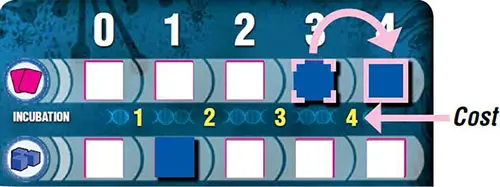
In this example, Blue must discard 4 cards of any color to advance the Incubation mutation from level 3 to level 4.
-

Incubation
Number of Contagion cards you may draw into your hand with the Draw Cards action.
-
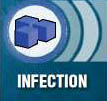
Infection
Number of disease cubes you may place in a city with the Infect a City action.
-

Resistance
Number of cards, cubes or mutations (elements) you may protect from Event and WHO cards.
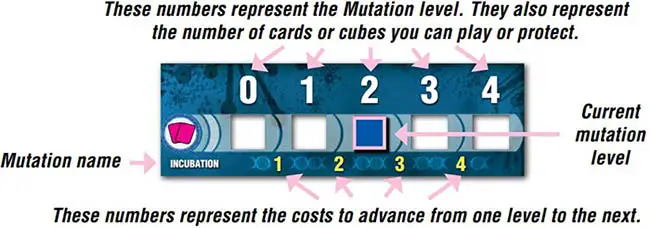
Resistance
Your disease's resistance allows you to protect your cards, cubes or mutations from effects of Event or WHO cards.
Each level allows you to protect up to as many elements (cards, cubes, mutations) as its number (e.g. Resistance level 3 protects up to 3 cubes). Whenever you use your resistance, you must move your resistance cube down one level.
Example: The A cure is found! WHO card states that players must remove 4 disease cubes. Blue has 3 cubes in various cities and her Resistance is at level 2. She decides to lower her Resistance to level 1 to save 2 cubes.
Since her Resistance is now at Level 1, she could save her last cube by lowering her Resistance to Level 0.
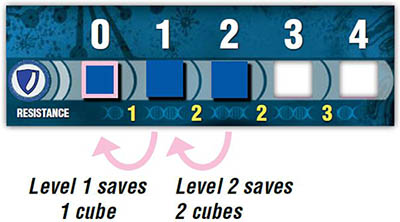
Event Cards
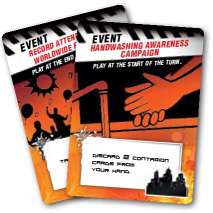
Political, weather or social events that can have positive or negative effects on the spread of your disease.
When an Event card is revealed, that card becomes active and must be resolved during each player's turn for the next game round
Note: Where cards differ from rules;, always go by what the cards say
New City 
Whenever a City symbol appears on an Event card, add a new City card from the City deck to the play area. This is the only time new cities are added to the game.
Who Cards
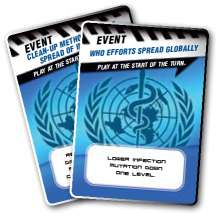
The World Health Organization's goal is to eradicate diseases.
When a WHO card is revealed, that card becomes active and must be resolved on each player's turn for the next game round.
Note: When a WHO card forces you to remove disease cubes, you must remove all of them if possible, and these can be from multiple cities.
Scoring
During the game, players will be able to score points when Death Toll and City Eradication scorings occur. Use the scoring board to keep track of the scores.
Death Toll Scoring 
You reveal one card from the Event deck at the beginning of each round. When the second (also fourth and sixth) Skull & Bones appears on an Event card, score all infected cities immediately.
The player with the most disease cubes (for each city) scores the lowest number on the card. If tied, the player who played on the city first (closest to the top of the card) wins.
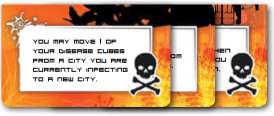
Skulls & Bones do not have to be revealed one right after the other to trigger a Death Toll scoring.
City Eradication
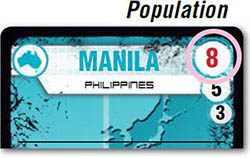
Each city has an approximate population number in millions (biggest number, and maximum number of disease cubes that may be placed on that city).
Each disease cube represents 1 million infected.
Thus, when the number of disease cubes equals the city's population number, it is no longer possible to play disease cubes there (since no one is left to infect) and proceed with a City Eradication scoring.
Notes on City card actions: The player who placed the final disease cube gets to play the City card action. Once acquired, Play immediately cards are used immediately after scoring and flipped facedown on the table.
Play when you want cards work in exactly the same way, except that they can also be kept and saved for later use.
City card actions do not count as part of your 2 actions. They are free actions. Where City cards differ from rules, always go by what the cards say.
Important: Resistance does not protect you from City card actions
City Eradication Scoring
When a City Eradication Scoring occurs, tally the points for that city. The player with the most disease cubes scores the full population number. The player with second most disease cubes scores the second lowest number.
The third highest scores the third lowest number. If tied, the player who played on the city first (closest to the top of the card) wins (just like in a Death Toll scoring). After scoring, players take their disease cubes back.
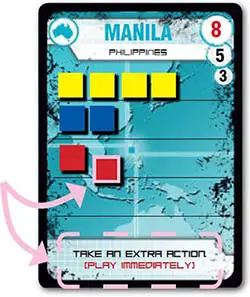
In this example, Yellow scores 8 points.
Blue and Red are tied, but since Blue infected the city first, she gets to score 5 points.
Then Red scores 3 points.
Since Red played the last cube necessary to wipe out the city, this allows him to play the special action of the City card.
End of the Game
When the last WHO card is revealed OR when there are only two cities left at any time on the table, complete the round and end the game.
During the game, players scored points for Death Tolls and City Eradications, which they tracked on the scoring board.
At the end of the game, perform one final Death Toll scoring for all remaining infected cities.
Add To This: The cumulative total of each Mutation level you have achieved during the game. This grand total gives you your final score.
The person with the highest score overall wins. If tied, the player with the highest cumulative total of all three mutations wins. If still tied, rejoice in shared victory.
For 2 Players
Remove all City cards that do not show the  icon on their bottom right corner.
icon on their bottom right corner.
Shuffle the remaining cards and place 6 City cards faceup on the table. Set the rest aside. At the start of each round, before revealing the Event card, turn over a Contagion card and place a neutral color disease cube in a city of that color.
If there are more than one city of that color, place it in the city with the highest population number. If the color does not match any city, draw until one does. Score the neutral color as you would for another player.
Note: WHO cards do not affect the neutral color cubes.
Continue Reading


